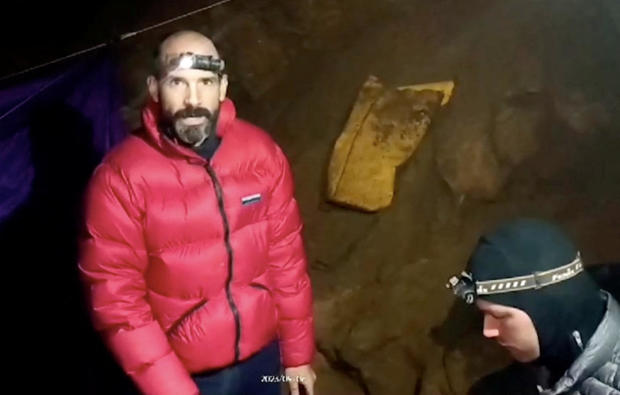Turkey cave rescue of American Mark Dickey like "Himalayan Mountain climbing" underground, friend says
Scores of international rescuers had descended by Friday on a cave in southern Turkey, as the plan to save American caver Mark Dickey took shape. Dickey, a speleologist or cave expert, fell ill last weekend while helping to chart Turkey's Morca cave system — the country's third deepest and sixth longest — leaving him stuck more than 3,200 underground.
Rescuers finally reached him around the middle of the week. The long, slow ascent was expected to begin as soon as Friday.
"I'm alert, I'm talking, but I'm not healed on the inside yet," Dickey said in a video clip that emerged from the depths Thursday, in which he's seen speaking with the rescuers who brought him desperately needed blood and other fluids.
"I do know that the quick response of the Turkish government to get the medical supplies that I need, in my opinion, saved my life. I was very close to the edge," the veteran U.S. cave scientist said in the video, shared by Turkish officials.
His stomach started bleeding on September 2 as he explored the cave with a handful of others, including several other Americans. With Dickey, himself a cave rescuer, unable to climb out on his own steam, volunteers from across Europe rushed to the scene and climbed in.
Dickey, 40, got stuck in a section of the cave system known serendipitously as "Camp Hope." From there, the return path will cover a distance more than double the height of the Empire State Building, with tight squeezes, tight turns and frigid water.
Carl Heitmeyer, a friend of Dickey's and fellow cave rescuer based in New Jersey, equated the extraction to "Himalayan Mountain climbing," but for cavers.
"When you're fit and strong you can make that climb… you can squirm through, you can twist your body, you can contort yourself," he told CBS News. "When you're feeling sick, this is all very strenuous activity."
Dickey and his rescuers will be working in the dark, in 40-degree cold, drenched from pools and waterfalls. Depending on Dickey's condition, they may decide to haul him out on a stretcher, at least part of the way, painstakingly connecting and disconnecting him from about 70 rope systems.
"If they make it from where he's at to intermediate camp — 300 meters in one day — I think it's reasonable to expect they can continue onward," said Heitmeyer. "One concern I have if his body is trying to heal itself and bleeds… it may open those wounds back up."
A healthy caver could make the ascent in about 15 hours. But getting Dickey out is expected to take at least a few days, and in a worst-case scenario, it could be two weeks or more before he's brought to the surface.
Dickey himself said that caving and cave rescues often present "a great opportunity to show just how well the international world can work together."
With more than 150 rescuers from across Europe now on hand to help get him back into daylight, his sentiment appeared well-founded.







